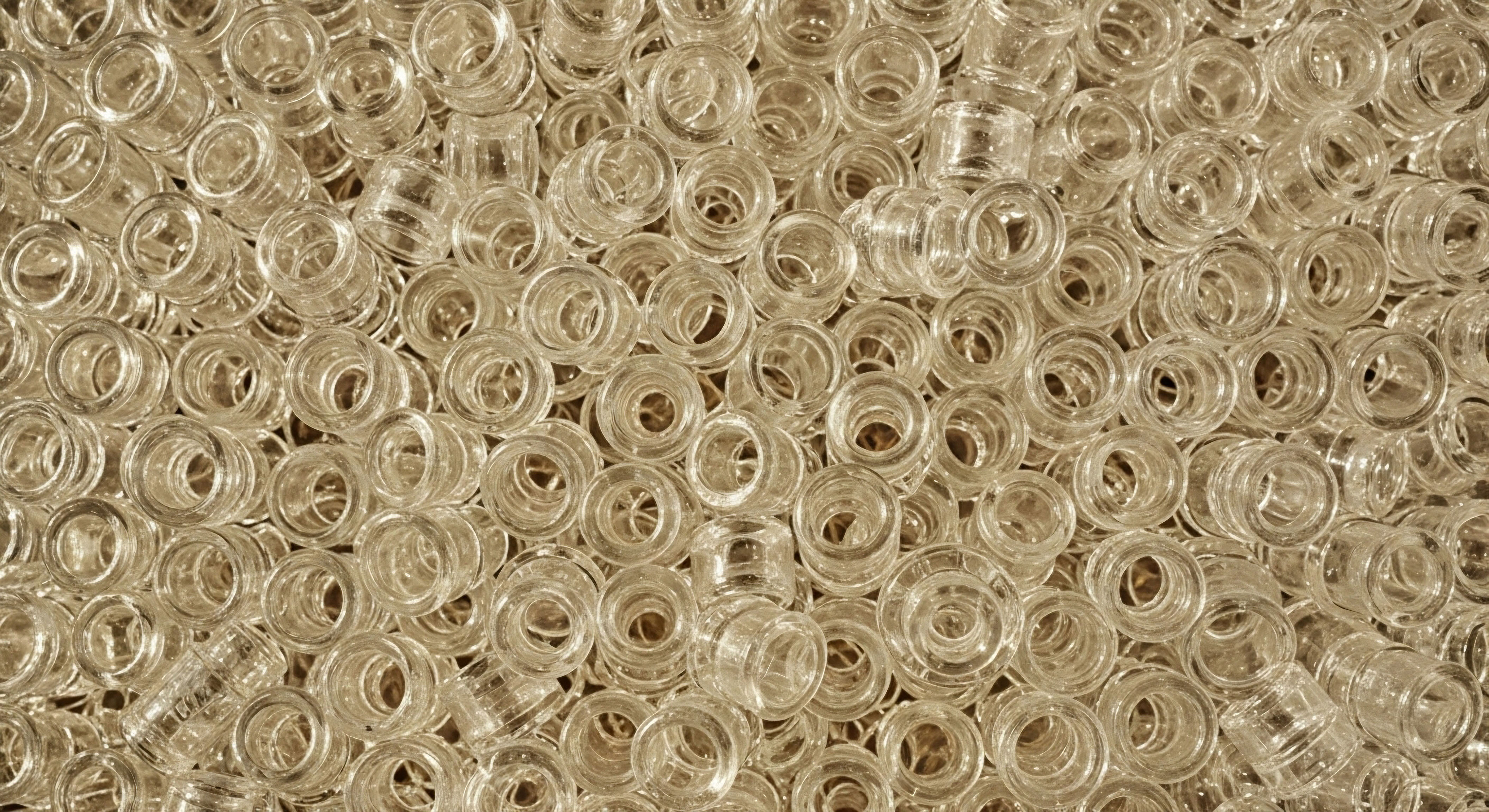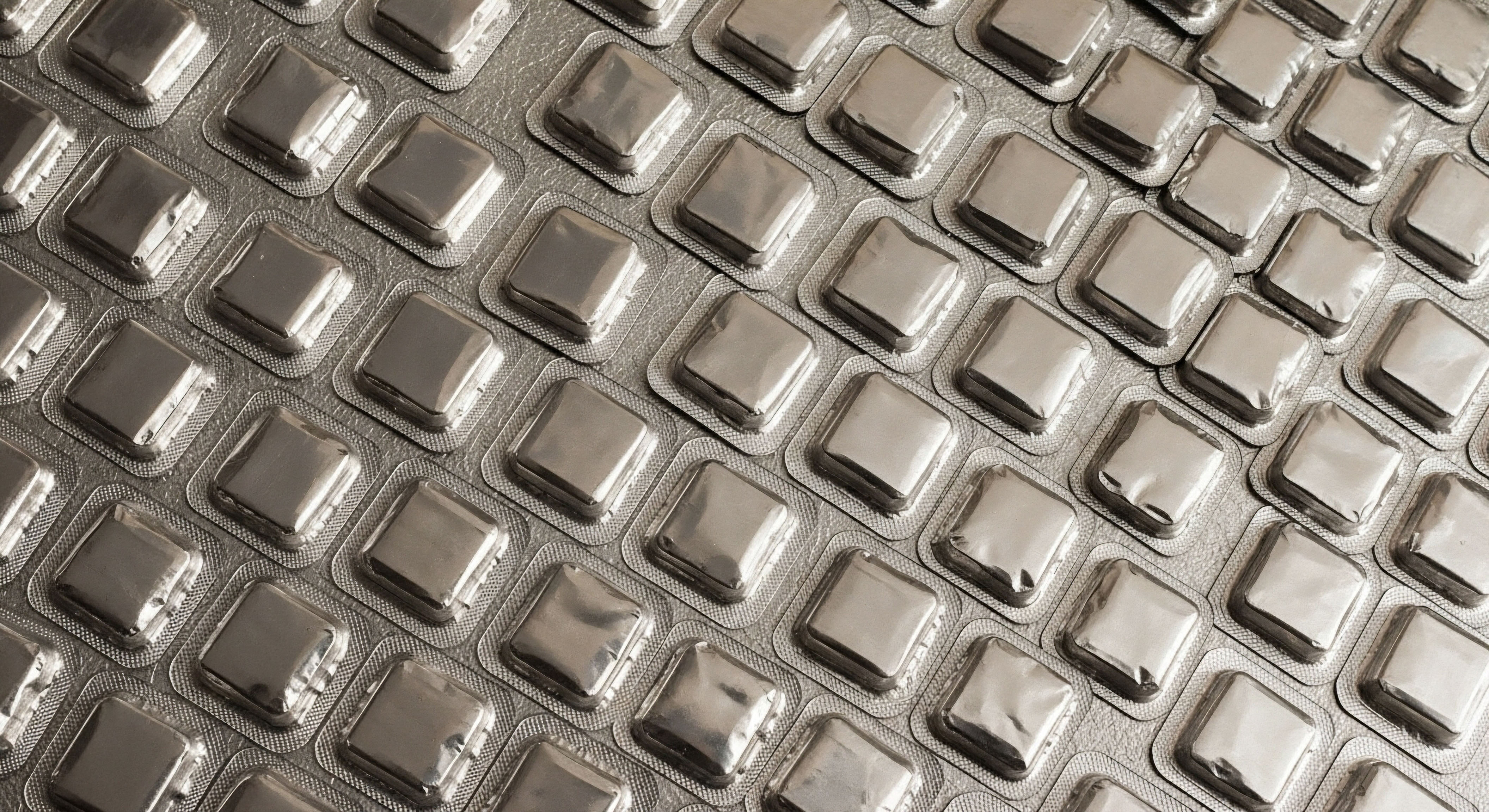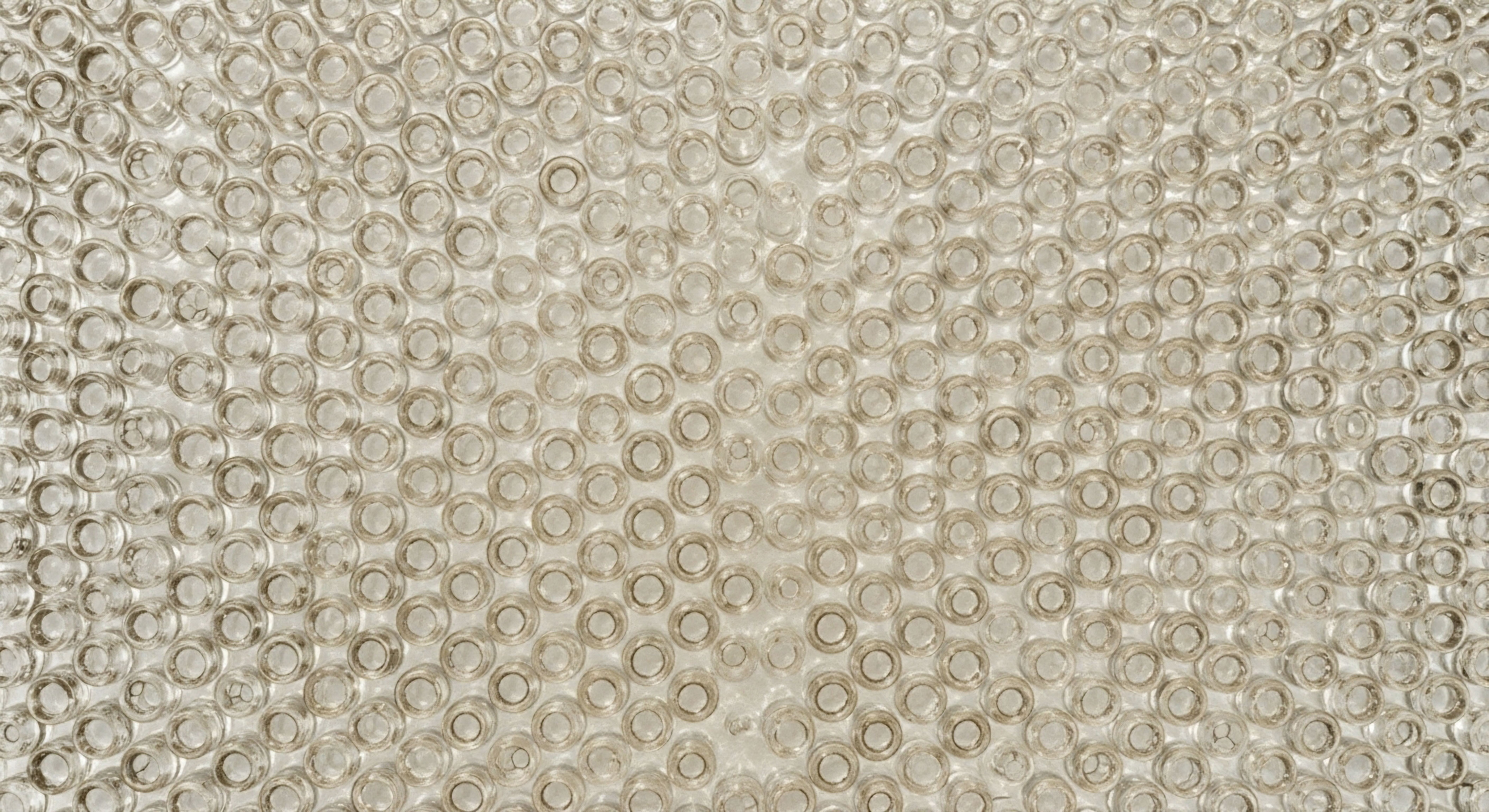

Fundamentals
A profound shift often occurs when considering hormonal optimization. Many individuals experiencing the subtle yet pervasive symptoms of declining vitality ∞ a persistent fatigue, a fading drive, or a diminished sense of well-being ∞ seek solutions. When the path leads to testosterone replacement therapy, a new set of considerations arises, particularly for those who hold the possibility of future family expansion.
The question of how to maintain fertility while pursuing hormonal balance is a deeply personal and significant concern. It speaks to a desire for wholeness, for addressing current symptoms without compromising future aspirations. This exploration validates that experience, offering clarity on the biological systems at play and the pharmacological avenues available.
Understanding the body’s intricate internal communication system is the first step. The hypothalamic-pituitary-gonadal (HPG) axis serves as the central regulatory pathway for reproductive and hormonal function. This axis operates like a sophisticated thermostat, constantly adjusting hormone levels. The hypothalamus, a region in the brain, releases gonadotropin-releasing hormone (GnRH) in precise, rhythmic pulses.
This signal travels to the pituitary gland, a small but mighty organ situated at the base of the brain. In response, the pituitary secretes two crucial messengers ∞ luteinizing hormone (LH) and follicle-stimulating hormone (FSH).
These gonadotropins, LH and FSH, then travel through the bloodstream to the testes. LH primarily stimulates the Leydig cells within the testes to produce testosterone, the primary male sex hormone. FSH, on the other hand, acts on the Sertoli cells, which are essential for supporting and nourishing developing sperm cells, a process known as spermatogenesis.
The testosterone produced by the Leydig cells, along with FSH, creates the optimal environment within the testes for healthy sperm production. This delicate balance ensures both adequate testosterone levels for systemic well-being and robust sperm generation for reproductive capacity.
The body’s hormonal systems operate through intricate feedback loops, where external inputs can significantly alter internal balance.
When exogenous testosterone, meaning testosterone administered from outside the body, is introduced, the body’s natural feedback mechanisms detect these elevated levels. This detection signals the hypothalamus and pituitary gland to reduce their own production of GnRH, LH, and FSH. This suppression occurs because the body perceives it has sufficient testosterone, thus halting the internal signaling cascade.
The consequence of this suppression is a significant reduction in the testes’ own testosterone production and, critically, a profound decrease in or complete cessation of spermatogenesis. This phenomenon explains why testosterone replacement therapy, while effective for addressing symptoms of low testosterone, can lead to impaired fertility.
The concern for fertility preservation during hormonal optimization is not a minor consideration; it reflects a fundamental aspect of human well-being and future planning. Individuals embarking on this journey deserve a clear understanding of how their biological systems respond to external hormonal inputs. The goal becomes not simply to replace a missing hormone, but to recalibrate the entire endocrine system, maintaining its inherent functions where possible. This requires a thoughtful, evidence-based approach that respects the body’s complex physiology.

How Does Exogenous Testosterone Affect Sperm Production?
The administration of external testosterone directly impacts the testicular environment. While systemic testosterone levels rise, the critical local concentration of testosterone within the testes, which is far higher than in the bloodstream, diminishes significantly. This localized reduction is a direct result of the suppressed LH and FSH signals.
Without sufficient LH stimulation, Leydig cells become less active, and without adequate FSH and intratesticular testosterone, the Sertoli cells cannot effectively support the maturation of sperm. The result is often a drastic reduction in sperm count, potentially leading to azoospermia, a complete absence of sperm in the ejaculate.
The duration of testosterone administration also influences the reversibility of this effect. Longer periods of exogenous testosterone use can make the recovery of natural spermatogenesis more challenging and prolonged after therapy cessation. This underscores the importance of proactive planning for fertility preservation before initiating testosterone replacement protocols. A comprehensive discussion with a healthcare provider about family planning goals is an essential component of any personalized wellness strategy involving hormonal interventions.


Intermediate
Addressing the intricate challenge of maintaining fertility while undergoing testosterone replacement therapy requires a strategic pharmacological approach. The aim is to counteract the suppressive effects of exogenous testosterone on the HPG axis, thereby preserving the testicular environment necessary for sperm production.
Several agents have demonstrated utility in this context, each operating through distinct mechanisms to support gonadotropin release or directly stimulate testicular function. These pharmacological interventions represent a sophisticated understanding of endocrine feedback loops, allowing for a more comprehensive and personalized hormonal optimization strategy.

Human Chorionic Gonadotropin
Human Chorionic Gonadotropin (hCG) is a glycoprotein hormone that shares structural and functional similarities with luteinizing hormone (LH). Its primary mechanism of action involves binding to the same LH receptors on the Leydig cells within the testes. By mimicking the action of LH, hCG directly stimulates the Leydig cells to produce endogenous testosterone.
This stimulation is crucial because it helps maintain the high intratesticular testosterone levels required for robust spermatogenesis, even when the pituitary’s own LH production is suppressed by exogenous testosterone.
Administering hCG alongside testosterone replacement therapy effectively sends a signal to the testes to continue their function, preventing the testicular atrophy and cessation of sperm production that often accompany testosterone monotherapy. Typical protocols involve subcutaneous injections of hCG, often administered two to three times per week.
Dosing can vary, but common ranges are between 250 IU and 1500 IU per injection, adjusted based on individual response and laboratory markers. Clinical studies have shown that men receiving low-dose hCG with testosterone replacement therapy can maintain intratesticular testosterone levels, with significantly less reduction compared to those on testosterone alone.
HCG acts as a vital messenger, signaling the testes to remain active and continue their natural functions despite external hormonal influences.
The use of hCG helps to preserve not only sperm production but also testicular size, which can be a concern for individuals on testosterone replacement therapy. While generally well-tolerated, potential side effects can include localized injection site reactions, fluid retention, or an increase in estrogen levels due to the stimulated testosterone production. Careful monitoring of estradiol levels is important when incorporating hCG into a treatment plan.

Gonadorelin and Its Role
Gonadorelin, a synthetic form of gonadotropin-releasing hormone (GnRH), represents another pharmacological avenue for fertility preservation. Unlike hCG, which directly stimulates the testes, gonadorelin acts higher up the HPG axis, at the level of the pituitary gland. When administered in a pulsatile fashion, mimicking the body’s natural GnRH release, gonadorelin stimulates the pituitary to secrete its own LH and FSH.
This approach aims to maintain the natural signaling pathway from the brain to the testes, thereby supporting endogenous testosterone production and spermatogenesis.
The pulsatile delivery of gonadorelin is key to its effectiveness, as continuous administration can lead to receptor desensitization and a paradoxical suppression of gonadotropin release. While less commonly used than hCG for fertility preservation during testosterone replacement therapy, gonadorelin offers a more physiological approach by stimulating the entire HPG axis.
Its application often involves subcutaneous injections, typically administered twice weekly, though specific dosing schedules vary. Gonadorelin may be particularly considered for individuals who wish to maintain their pituitary-testicular axis activity more directly.

Selective Estrogen Receptor Modulators
Selective Estrogen Receptor Modulators (SERMs), such as Clomiphene Citrate and Tamoxifen, offer an indirect but effective strategy for stimulating endogenous hormone production and preserving fertility. These compounds exert their effects by selectively blocking estrogen receptors in specific tissues, particularly in the hypothalamus and pituitary gland. Estrogen normally provides negative feedback to these brain regions, signaling them to reduce GnRH, LH, and FSH release. By blocking these receptors, SERMs effectively trick the hypothalamus and pituitary into perceiving lower estrogen levels.
This perceived reduction in estrogen removes the inhibitory brake on the HPG axis, leading to an increased secretion of GnRH, and subsequently, higher levels of LH and FSH from the pituitary. The elevated LH and FSH then stimulate the testes to produce more testosterone and support spermatogenesis.
Clomiphene Citrate is frequently used as a monotherapy to raise testosterone levels and improve fertility in men with hypogonadism who desire to maintain their reproductive capacity without resorting to exogenous testosterone. It can also be used in conjunction with testosterone replacement therapy to mitigate its suppressive effects.
Tamoxifen operates on a similar principle, acting as an estrogen receptor antagonist in the hypothalamus and pituitary. While primarily known for its role in breast cancer treatment, its ability to disinhibit the HPG axis makes it a valuable tool in male fertility protocols. Both clomiphene and tamoxifen are oral medications, offering a convenient administration route. Dosages are individualized, with clomiphene often starting at 25-50 mg daily or every other day, and tamoxifen typically at 10-20 mg daily.
SERMs recalibrate the body’s internal signaling, prompting a natural resurgence of hormonal activity.
While effective, SERMs can have side effects, including visual disturbances with clomiphene or potential impacts on liver enzymes. The choice between these agents, or their combination with testosterone replacement therapy, depends on individual patient profiles, fertility goals, and clinical assessment. A comprehensive discussion with a specialist is essential to determine the most appropriate protocol.

Aromatase Inhibitors
Aromatase Inhibitors (AIs), such as Anastrozole, are another class of medications sometimes used in conjunction with testosterone replacement therapy to manage estrogen levels. While their primary role is to prevent the conversion of testosterone into estrogen, thereby reducing estrogen-related side effects like gynecomastia, they can also indirectly influence fertility. By lowering systemic estrogen, AIs can reduce the negative feedback on the HPG axis, potentially allowing for some endogenous LH and FSH production.
However, AIs are generally not considered first-line agents for fertility preservation during testosterone replacement therapy. Their main utility lies in managing estrogenic side effects when other fertility-preserving agents are in use, or when used as a monotherapy for men with high estrogen and low testosterone. Over-suppression of estrogen can also be detrimental, as estrogen plays a role in spermatogenesis and bone health in men. Therefore, their use requires careful monitoring of estradiol levels to ensure balance.
The table below summarizes the primary pharmacological options for fertility preservation during testosterone replacement therapy, highlighting their mechanisms and typical applications.
| Pharmacological Agent | Primary Mechanism of Action | Impact on Fertility During TRT | Typical Administration |
|---|---|---|---|
| Human Chorionic Gonadotropin (hCG) | Mimics LH, directly stimulates Leydig cells to produce intratesticular testosterone. | Maintains intratesticular testosterone and supports spermatogenesis. | Subcutaneous injection, 2-3 times weekly. |
| Gonadorelin | Pulsatile stimulation of pituitary to release LH and FSH. | Supports natural HPG axis activity, promoting endogenous testosterone and spermatogenesis. | Subcutaneous injection, 2 times weekly. |
| Clomiphene Citrate (SERM) | Blocks estrogen receptors in hypothalamus/pituitary, increasing LH/FSH release. | Stimulates endogenous testosterone and spermatogenesis; often used as monotherapy. | Oral tablet, daily or every other day. |
| Tamoxifen (SERM) | Blocks estrogen receptors in hypothalamus/pituitary, increasing LH/FSH release. | Similar to clomiphene; stimulates endogenous testosterone and spermatogenesis. | Oral tablet, daily. |
| Anastrozole (AI) | Inhibits testosterone-to-estrogen conversion, reducing negative feedback. | Indirectly supports HPG axis by lowering estrogen; primarily for estrogen management. | Oral tablet, 2 times weekly. |
Each of these agents offers a distinct pathway to support reproductive function when exogenous testosterone is part of a wellness protocol. The selection of the most appropriate agent, or a combination of agents, is a highly individualized decision. It requires a thorough assessment of the individual’s hormonal profile, fertility aspirations, and overall health status. The goal remains to optimize systemic well-being while safeguarding the intricate biological processes that underpin reproductive capacity.


Academic
The preservation of male fertility during testosterone replacement therapy represents a complex endocrinological challenge, necessitating a deep understanding of the hypothalamic-pituitary-gonadal (HPG) axis and its intricate feedback mechanisms.
Exogenous testosterone, while effective in ameliorating symptoms of hypogonadism, exerts a potent negative feedback on the hypothalamus and pituitary gland, leading to a profound suppression of endogenous gonadotropin-releasing hormone (GnRH), luteinizing hormone (LH), and follicle-stimulating hormone (FSH) secretion. This suppression is the primary driver of impaired spermatogenesis, as the testes become deprived of the necessary trophic support for both Leydig cell function and Sertoli cell activity.
The physiological basis for this impairment lies in the absolute requirement for high intratesticular testosterone concentrations to drive spermatogenesis. While systemic testosterone levels may be normalized or even supraphysiological with exogenous administration, the local testicular environment experiences a drastic reduction in testosterone due to the suppressed LH-mediated Leydig cell steroidogenesis.
Studies have demonstrated that intratesticular testosterone levels can plummet by over 90% in men on testosterone monotherapy, a condition incompatible with normal sperm production. The pharmacological strategies employed to mitigate this effect aim to restore or maintain this critical intratesticular milieu.

Mechanisms of Gonadotropin Support
The cornerstone of fertility preservation protocols during testosterone replacement therapy involves the re-establishment of gonadotropin signaling to the testes.
- Human Chorionic Gonadotropin (hCG) Analogues ∞ hCG, a placental glycoprotein, structurally resembles LH and binds to the same LH receptors on Leydig cells. Its administration directly stimulates Leydig cell steroidogenesis, thereby maintaining intratesticular testosterone levels.
This direct stimulation bypasses the suppressed pituitary, ensuring that the testes continue to produce the high local testosterone concentrations essential for germ cell development. Clinical data supports the efficacy of concomitant low-dose hCG (e.g. 250-500 IU every other day) in preventing significant declines in intratesticular testosterone and preserving spermatogenesis in men receiving exogenous testosterone.
The longer half-life of hCG compared to endogenous LH makes it a practical therapeutic agent for pulsatile stimulation.
- Gonadotropin-Releasing Hormone (GnRH) Analogues ∞ Gonadorelin, a synthetic GnRH decapeptide, acts at the hypothalamic-pituitary level. When administered in a pulsatile fashion, mimicking the physiological release pattern of endogenous GnRH, it stimulates the pituitary to secrete LH and FSH.
This approach seeks to reactivate the entire HPG axis, providing the natural gonadotropin signals necessary for both Leydig cell and Sertoli cell function. The challenge with gonadorelin lies in maintaining its pulsatile delivery to avoid receptor desensitization, which would lead to a paradoxical suppression of gonadotropins. While theoretically more physiological, its practical application for fertility preservation in the context of ongoing testosterone replacement therapy is less common than hCG, often reserved for specific cases of hypogonadotropic hypogonadism.

Modulating Estrogen Feedback
The role of estrogen in male reproductive physiology, particularly its negative feedback on the HPG axis, is a critical consideration. Estrogen, primarily derived from the aromatization of testosterone, exerts inhibitory effects on GnRH, LH, and FSH secretion. Pharmacological agents that modulate estrogen signaling can therefore indirectly stimulate endogenous gonadotropin production.
- Selective Estrogen Receptor Modulators (SERMs) ∞ Compounds like clomiphene citrate and tamoxifen act as competitive antagonists at estrogen receptors in the hypothalamus and pituitary gland. By blocking these receptors, SERMs prevent estrogen from exerting its negative feedback, thereby disinhibiting GnRH release.
This leads to an upregulation of LH and FSH secretion from the pituitary, which in turn stimulates testicular testosterone production and spermatogenesis. Clomiphene citrate is widely utilized as a monotherapy for men with hypogonadotropic hypogonadism who desire fertility, as it can effectively raise endogenous testosterone and improve sperm parameters without introducing exogenous testosterone.
Tamoxifen, while having similar central effects, also possesses anti-estrogenic properties in breast tissue, making it useful for managing gynecomastia. The efficacy of SERMs in maintaining fertility during concurrent testosterone replacement therapy is a subject of ongoing research, but their ability to stimulate endogenous gonadotropins makes them valuable adjuncts or alternatives.
- Aromatase Inhibitors (AIs) ∞ Medications such as anastrozole inhibit the enzyme aromatase, which is responsible for converting androgens (like testosterone) into estrogens.
By reducing systemic estrogen levels, AIs can theoretically reduce estrogenic negative feedback on the HPG axis, thereby promoting LH and FSH release. However, the primary indication for AIs in men on testosterone replacement therapy is to manage elevated estradiol levels and associated side effects.
While they may offer some indirect support for gonadotropin production, their direct role in fertility preservation is secondary to agents like hCG or SERMs. Moreover, excessive estrogen suppression can have adverse effects on bone mineral density and lipid profiles in men, necessitating careful monitoring.

Clinical Considerations and Combination Therapies
The decision to implement fertility-preserving strategies during testosterone replacement therapy is highly individualized, contingent upon the patient’s age, baseline fertility status, duration of planned testosterone use, and reproductive goals. A comprehensive evaluation, including semen analysis and hormonal profiling (LH, FSH, total and free testosterone, estradiol), is essential prior to initiating any protocol.
For men who wish to maintain fertility while on long-term testosterone replacement therapy, a common approach involves co-administration of hCG. This strategy effectively maintains intratesticular testosterone and prevents testicular atrophy.
The typical protocol involves weekly intramuscular injections of Testosterone Cypionate (200mg/ml), combined with Gonadorelin (2x/week subcutaneous injections to maintain natural testosterone production and fertility) and Anastrozole (2x/week oral tablet to block estrogen conversion and reduce side effects). Enclomiphene may also be included to support LH and FSH levels.
In cases where a man has discontinued testosterone replacement therapy and wishes to restore fertility, a different protocol is often employed. This typically involves a combination of agents designed to vigorously reactivate the suppressed HPG axis.
- Gonadorelin ∞ Administered in a pulsatile manner to stimulate endogenous LH and FSH release.
- Tamoxifen ∞ Used to block estrogenic negative feedback at the hypothalamus and pituitary, thereby increasing gonadotropin secretion.
- Clomiphene ∞ Similar to tamoxifen, it acts as a SERM to disinhibit the HPG axis and promote endogenous testosterone and sperm production.
- Anastrozole (optional) ∞ May be included to manage estrogen levels, particularly if there is a concern for excessive aromatization during the recovery phase.
The duration of these post-testosterone replacement therapy protocols can vary, often requiring several months for full spermatogenesis recovery, and in some instances, recovery may be prolonged or incomplete. Patient counseling regarding these timelines and potential outcomes is paramount.
The table below outlines the comparative effects of different pharmacological agents on key reproductive parameters.
| Agent Class | Effect on LH/FSH | Effect on Endogenous Testosterone | Effect on Intratesticular Testosterone | Effect on Spermatogenesis |
|---|---|---|---|---|
| Exogenous Testosterone (Monotherapy) | Suppressed | Suppressed | Severely Decreased | Suppressed / Azoospermia |
| hCG (with TRT) | LH mimicked, FSH still suppressed | Maintained/Stimulated | Maintained | Preserved |
| Gonadorelin (with TRT) | Stimulated (pulsatile) | Stimulated | Maintained | Preserved |
| SERMs (Clomiphene/Tamoxifen) | Stimulated | Stimulated | Increased | Improved/Stimulated |
| Aromatase Inhibitors | Indirectly increased (due to lower estrogen feedback) | Increased (due to lower estrogen feedback) | Variable, potentially maintained | Variable, potentially maintained |
The intricate interplay of these hormonal pathways underscores the need for a highly individualized and medically supervised approach to fertility preservation during testosterone replacement therapy. The goal is to navigate the complexities of endocrine regulation, ensuring that the pursuit of vitality and optimal function does not inadvertently compromise the capacity for future reproduction. This requires a deep understanding of the underlying biological mechanisms and a commitment to evidence-based clinical practice.

Are There Long-Term Implications for Fertility Preservation Strategies?
Considering the long-term implications of fertility preservation strategies during testosterone replacement therapy is essential for comprehensive patient care. While the immediate goal is to maintain spermatogenesis, the sustained impact of these interventions on testicular health and future reproductive potential warrants ongoing investigation.
The prolonged use of agents like hCG, while effective in maintaining intratesticular testosterone, requires continuous monitoring for potential side effects such as testicular desensitization or alterations in Leydig cell function over many years. Similarly, the long-term effects of SERMs on testicular morphology and function, beyond their immediate impact on gonadotropin release, are areas of continued clinical interest.
The recovery of spermatogenesis after cessation of testosterone replacement therapy, even with adjunctive agents, is not universally guaranteed and can be a protracted process. Some individuals may experience persistent oligozoospermia or azoospermia, highlighting the importance of pre-treatment counseling regarding potential irreversibility.
Cryopreservation of sperm prior to initiating testosterone replacement therapy remains a robust option for men with clear fertility aspirations, offering a safeguard against potential long-term reproductive impairment. This proactive measure provides a tangible option for future family building, independent of the complexities of hormonal recovery protocols.

References
- Finkelstein, Joel S. et al. “Gonadotropin-releasing hormone (GnRH) pulse generator activity in men with idiopathic hypogonadotropic hypogonadism.” Journal of Clinical Endocrinology & Metabolism, vol. 88, no. 10, 2003, pp. 4683-4690.
- Kicman, Antony T. “Pharmacology of anabolic steroids.” British Journal of Pharmacology, vol. 136, no. 7, 2008, pp. 941-949.
- Liu, Peter Y. et al. “Human chorionic gonadotropin and testosterone in the treatment of male hypogonadism.” Journal of Clinical Endocrinology & Metabolism, vol. 93, no. 8, 2008, pp. 3121-3128.
- Rastrelli, Giacomo, et al. “Testosterone replacement therapy and male infertility.” Reviews in Endocrine and Metabolic Disorders, vol. 18, no. 3, 2017, pp. 315-322.
- Shabsigh, Ridwan, et al. “The role of human chorionic gonadotropin in the management of male hypogonadism.” Journal of Sexual Medicine, vol. 7, no. 1, 2010, pp. 261-267.
- Weinbauer, G. F. and E. Nieschlag. “Gonadotropin-releasing hormone (GnRH) agonists and antagonists in male contraception.” Human Reproduction Update, vol. 1, no. 2, 1995, pp. 107-124.
- Wiebe, H. R. and A. M. Traish. “Testosterone and the aging male ∞ a review of the physiological and clinical aspects.” Journal of Andrology, vol. 27, no. 3, 2006, pp. 313-323.
- Yildirim, M. E. et al. “The effect of clomiphene citrate on semen parameters and serum hormone levels in men with idiopathic oligoasthenoteratozoospermia.” Andrologia, vol. 49, no. 1, 2017, e12586.

Reflection
The journey toward understanding your own biological systems is a powerful act of self-advocacy. This exploration of fertility preservation during testosterone replacement therapy is not merely a collection of clinical facts; it is an invitation to consider the profound interconnectedness of your body’s functions. Each decision regarding hormonal health carries implications that extend beyond immediate symptom relief, touching upon the very fabric of your vitality and future potential.
Recognizing the sophisticated mechanisms that govern your endocrine system allows for a more informed and proactive stance in your wellness journey. The knowledge gained here serves as a foundation, a starting point for deeper conversations with your healthcare team. Your personal aspirations, whether related to family building or simply optimizing your physiological function, deserve a tailored approach. This path is about reclaiming control, aligning your biological systems with your life’s vision, and stepping forward with clarity and confidence.



